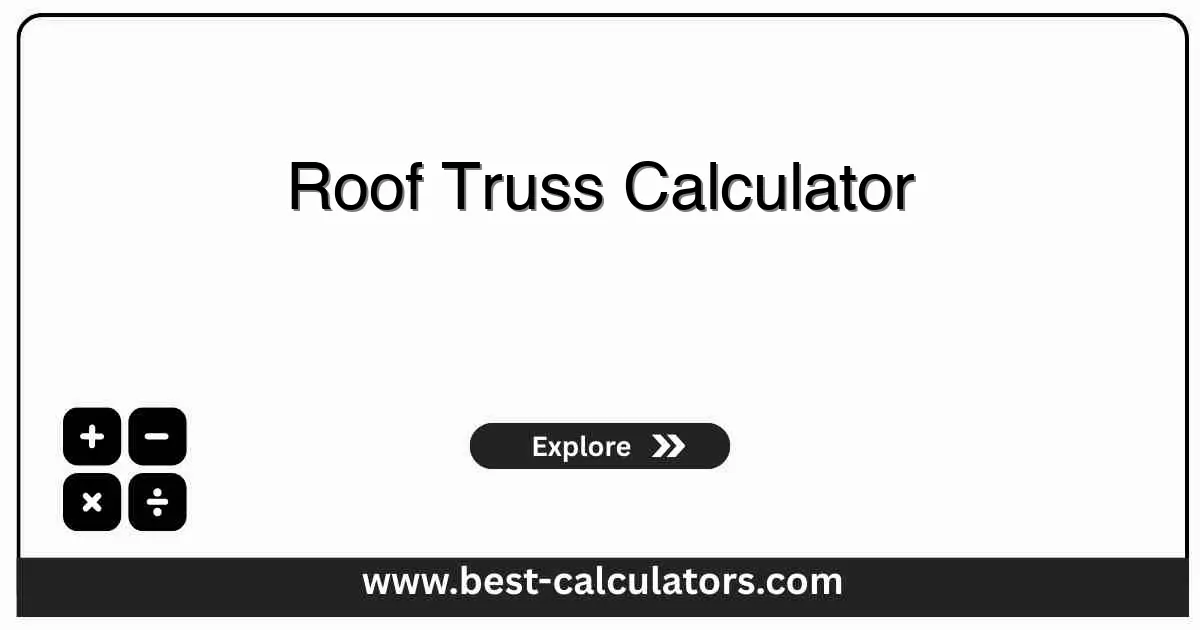Roof Truss Calculator - Calculate Truss Dimensions, Materials & Costs
Free calculator to determine precise roof truss measurements including rafter length, number of trusses, lumber requirements, and cost estimates for construction projects
Roof Truss Calculator
Results
What is a Roof Truss Calculator?
A Roof Truss Calculator is a free construction tool that helps you determine the exact dimensions, materials, and costs for roof truss installation. It calculates rafter lengths, number of trusses needed, lumber requirements, and material costs for accurate project planning and budgeting.
For comprehensive construction planning, you might also need our Stair Calculator for precise structural measurements, Snow Load Calculator for roof design considerations, or Size to Weight Calculator for lumber weight calculations.
This calculator works for:
- New Home Construction - Plan truss requirements for new builds
- Roof Replacement - Calculate materials for existing structure updates
- DIY Projects - Determine truss needs for home improvement
- Commercial Buildings - Plan large-scale roof truss systems
How Roof Truss Calculation Works
The calculation uses these formulas:
Where:
- Rise = Roof pitch in feet
- Run = Half the building span
- Board Feet = Total lumber needed for all trusses
- Material Cost = Board feet × cost per board foot
Key Roof Truss Concepts Explained
Truss Spacing
Distance between trusses measured center to center, typically 24 inches for residential construction.
Rafter Length
Total length from ridge to wall plate including overhang, calculated using Pythagorean theorem.
Board Feet
Unit of lumber measurement calculated as (Thickness × Width × Length) ÷ 144 for total material estimation.
Building Span
Total width from exterior wall to exterior wall, determining structural requirements and truss size.
How to Use This Roof Truss Calculator
Enter Building Dimensions
Input span, length, and spacing measurements
Set Roof Pitch
Specify rise per foot for roof slope
Add Cost Information
Include lumber costs and waste factors
Review Results
Get complete truss and material requirements
Benefits of Using This Calculator
- • Accurate Material Planning: Get precise lumber quantities to avoid overbuying or shortages.
- • Cost Estimation: Calculate material costs for budget planning and project quotes.
- • Code Compliance: Ensure truss spacing and sizing meets building code requirements.
- • Project Efficiency: Streamline truss ordering and construction planning.
Factors That Affect Your Results
1. Local Building Codes
Different regions have specific requirements for truss spacing, load calculations, and engineering requirements.
2. Roof Load Requirements
Snow loads, wind loads, and live loads affect truss design and spacing requirements.
3. Lumber Grades and Species
Higher grade lumber and certain species can span greater distances and support heavier loads.

Frequently Asked Questions (FAQ)
Q: How do I calculate roof truss requirements?
A: Roof truss requirements are calculated by determining the building span, roof pitch, truss spacing, and overhang. The basic formula is: Number of trusses = (Building length ÷ Truss spacing) + 1. Rafter length is calculated using the Pythagorean theorem: √(Rise² + Run²).
Q: What is the standard truss spacing?
A: Standard truss spacing is typically 24 inches on center for residential construction, though 16-inch spacing is sometimes used for heavier loads or longer spans. Commercial buildings may use 24-inch to 48-inch spacing depending on structural requirements.
Q: How much lumber do I need for roof trusses?
A: Lumber requirements depend on span, pitch, and loading. A typical residential truss uses 2×6, 2×8, or 2×10 lumber for top and bottom chords, with 2×4 lumber for web members. Calculate total linear footage by multiplying member lengths by the number of trusses needed.
Q: What is the difference between a truss and a rafter?
A: A rafter is a single piece of lumber that extends from ridge to wall plate, while a truss is a prefabricated triangular framework that distributes loads more efficiently. Trusses typically span longer distances and require less lumber than conventional rafters.